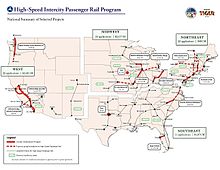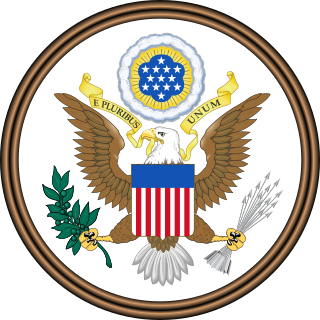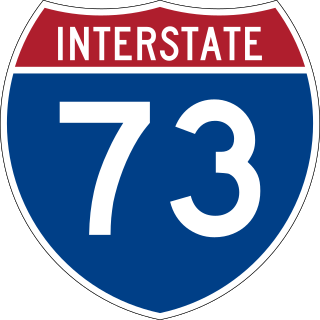| Corridor # | Name | Location | Notes |
|---|
| 1 | North-South Corridor | Kansas City, Missouri to Shreveport, Louisiana | Interstate 49 |
| 2 | Avenue of the Saints Corridor | St. Louis, Missouri to St. Paul, Minnesota |
| 3 | East-West Transamerica Corridor | Hampton Roads, Virginia to southern Kansas | Interstate 66 (Kansas–Kentucky)
Project officially cancelled on August 6, 2015 |
| 4 | Hoosier Heartland Industrial Corridor | Lafayette, Indiana to Toledo, Ohio |
| 5 | I-73/74 North-South Corridor | Myrtle Beach, South Carolina to Cincinnati, Ohio, Detroit, Michigan and Sault Ste. Marie, Michigan |
| 6 | United States Route 80 Corridor | Meridian, Mississippi to Savannah, Georgia |
| 7 | East-West Corridor | Memphis, Tennessee to Atlanta, Georgia and Chattanooga, Tennessee |
| 8 | Highway 412 East-West Corridor | Tulsa, Oklahoma to Nashville, Tennessee |
| 9 | United States Route 220 and the Appalachian Thruway Corridor | Bedford, Pennsylvania to Corning, New York | Interstate 99 |
| 10 | Appalachian Regional Corridor X | Fulton, Mississippi to Birmingham, Alabama [5] [6] [7] | See corridor 45 |
| 11 | Appalachian Regional Corridor V | From Interstate 55 in northern Mississippi in the west to Interstate 24 in East Tennessee | Route is from Batesville, Mississippi, and via Tupelo, Mississippi, Russellville, Alabama, and Huntsville, Alabama, ending just west of Chattanooga, Tennessee [6] [7] See also corridor 42. |
| 12 | United States Route 25E Corridor | Corbin, Kentucky to Morristown, Tennessee |
| 13 | Raleigh-Norfolk Corridor | Raleigh, North Carolina to Norfolk, Virginia | Interstate 87 (North Carolina–Virginia) |
| 14 | Heartland Expressway | Denver, Colorado to Rapid City, South Dakota |
| 15 | Urban Highway Corridor | M-59 in Michigan |
| 16 | Economic Lifeline Corridor | I-15 and I-40 in California, Arizona, and Nevada |
| 17 | Route 29 Corridor | Greensboro, North Carolina to Washington, D.C. |
| 18 | | Port Huron, Michigan to Chicago, Illinois, Corpus Christi, Texas and Victoria, Texas | Interstate 69 (see Corridor 20) |
| 19 | United States Route 395 Corridor | Canada–US border to Reno, Nevada |
| 20 | United States Route 59 Corridor | Laredo, Texas to Texarkana, Texas | Interstate 69 (see Corridor 18) |
| 21 | United States Route 219 Corridor | Buffalo, New York to Interstate 80 |
| 22 | Alameda Transportation Corridor | Ports of Los Angeles and Long Beach to Interstate 10 | (See Corridor 34) |
| 23 | Interstate Route 35 Corridor | Laredo, Texas to Duluth, Minnesota and the Canada–US border (via Interstate 29) |
| 24 | Dalton Highway | Deadhorse, Alaska to Fairbanks, Alaska |
| 25 | State Route 168 (South Battlefield Boulevard) | Great Bridge, Virginia Bypass to the North Carolina state line |
| 26 | CANAMEX Corridor | Nogales, Arizona to the Canada–US border |
| 27 | Camino Real Corridor | El Paso, Texas to the Canada–US border |
| 28 | Birmingham Northern Beltline | Birmingham, Alabama | Appalachian Highway Development System Corridor X-1 [5] |
| 29 | Coalfields Expressway | Beckley, West Virginia to Pound, Virginia |
| 30 | Interstate Route 5 | California, Oregon and Washington |
| 31 | Mon–Fayette Expressway and Southern Beltway | Pennsylvania and West Virginia |
| 32 | Wisconsin Development Corridor | Dubuque, Iowa to Eau Claire, Wisconsin | Consists of three different corridors in the state of Wisconsin |
| 33 | Capital Gateway Corridor | Washington, D.C. to the Baltimore-Washington Parkway in Maryland | U.S. Route 50 |
| 34 | Alameda Corridor-East and Southwest Passage | East Los Angeles, California to Barstow, California and Coachella, California, and San Bernardino, California to Arizona | (See Corridor 22) |
| 35 | Everett-Tacoma FAST Corridor | Everett, Washington to Tacoma, Washington |
| 36 | NY-17 | Harriman, New York to I-90 in Pennsylvania | ISTEA mandates that route be Interstate 86 |
| 37 | United States Route 90 | Lafayette, Louisiana to New Orleans, Louisiana | Interstate 49 |
| 38 | Ports to Plains Corridor | Laredo, Texas to Denver, Colorado | Interstate 27 (Lubbock, Texas to Amarillo, Texas) |
| 39 | United States Route 63 | Marked Tree, Arkansas to Interstate 55 | Interstate 555 |
| 40 | Greensboro Corridor | Danville, Virginia to Greensboro, North Carolina | Interstate 785 |
| 41 | Falls-to-Falls Corridor | International Falls, Minnesota to Chippewa Falls, Wisconsin |
| 42 | | Batesville to Fulton, Mississippi | formed from portions of ADHS corridors V and X; law designates highway as a future Interstate highway (route number not specified in law) |
| 43 | United States Route 95 Corridor | Eastport, Idaho to Oregon |
| 44 | Louisiana Highway 1 Corridor | Grand Isle, Louisiana to U.S. Route 90 |
| 45 | United States Route 78 Corridor | Memphis, Tennessee to Birmingham, Alabama | Interstate 22 |
| 46 | Interstate Route 710 | Long Beach, California to California State Route 60 |
| 47 | Interstate Route 87 | Quebec to New York City |
| 48 | Route 50 High Plains Corridor | Newton, Kansas to Pueblo, Colorado |
| 49 | Atlantic Commerce Corridor | Jacksonville, Florida to Miami, Florida |
| 50 | East-West Corridor | Watertown, New York to Calais, Maine |
| 51 | SPIRIT Corridor | El Paso, Texas to Wichita, Kansas |
| 52 | | Swifton, Arkansas to Jonesboro, Arkansas |
| 53 | United States Highway Route 6 | Interstate 70 to Interstate 15 |
| 54 | California Farm-to-Market Corridor | south of Bakersfield, California to Sacramento, California | California State Route 99 |
| 55 | | Dallas, Texas to Memphis, Tennessee |
| 56 | La Entrada al Pacifico Corridor | Lamesa, Texas to Presidio, Texas |
| 57 | United States Route 41 corridor | Milwaukee, Wisconsin to Green Bay, Wisconsin | Interstate 41 |
| 58 | Theodore Roosevelt Expressway | Rapid City, South Dakota to Raymond, Montana |
| 59 | Central North American Trade Corridor | border between North Dakota and South Dakota to the Canada–US border |
| 60 | Providence Beltline Corridor | Hope Valley, Rhode Island to Massachusetts |
| 61 | | various corridors in Missouri |
| 62 | Georgia Developmental Highway System Corridors | various corridors in Georgia |
| 63 | Liberty Corridor | various corridors in northern New Jersey |
| 64 | | various corridors in southern New Jersey |
| 65 | Interstate Route 95 Corridor | Connecticut |
| 66 | Interstate Route 91 Corridor | Connecticut |
| 67 | Fairbanks-Yukon International Corridor | Canada–US border to Fairbanks, Alaska |
| 68 | Washoe County corridor | Reno, Nevada to Las Vegas, Nevada |
| 69 | Cross Valley Connector | Interstate 5 to State Route 14, Santa Clarita Valley, California |
| 70 | Economic Lifeline corridor | I-15, I-40 and other roads in California, Arizona and Nevada |
| 71 | High Desert Corridor | Los Angeles, California to Las Vegas, Nevada |
| 72 | North-South corridor | Kansas City, Missouri to Shreveport, Louisiana | Interstate 49 |
| 73 | Louisiana Highway corridor | Grand Isle, Louisiana to U.S. Route 90 |
| 74 | | Lafayette, Louisiana to New Orleans, Louisiana | Interstate 49 |
| 75 | Louisiana 28 corridor | Fort Polk, Louisiana to Alexandria, Louisiana |
| 76 | | Toledo, Ohio to Cincinnati, Ohio |
| 77 | | Indiana to Toledo, Ohio |
| 78 | | Cincinnati, Ohio to Cleveland, Ohio |
| 79 | Interstate Route 376 | Monroeville, Pennsylvania to Sharon, Pennsylvania |
| 80 | Intercounty Connector | Interstate 270 to Interstate 95/U.S. Route 1 in Maryland |
| 81 | Interstate 795 | Goldsboro, North Carolina to Interstate 40 west of Faison, North Carolina |
| 82 | U.S. Route 70 | U.S. 70 from Interstate 40 at Garner, North Carolina to the port of Morehead City, North Carolina | law designates highway as a future Interstate highway (route number not specified in law). Assigned Interstate 42 by AASHTO [8] |
| 83 | Sonoran Corridor (State Rte. 410) | A new highway from Interstate 19 to Interstate 10 south of Tucson International Airport, Arizona | law designates highway as a future Interstate highway (route number not specified in law) |
| 84 | Central Texas Corridor | Two routes from Interstate 10 (Pecos County) and Interstate 20 (Midland–Odessa), joining in Brady and continuing east to the Sabine River, passing in or near Fort Hood; College Station; Huntsville; and Livingston; all in Texas (paragraphs A–C) Also designates spurs from I-14 North in Eden to I-10 near Junction following U.S. 83 (paragraph D), from I-14 in Woodville to I-10 in Beaumont via U.S. 69 (paragraph E), from I-14 in Jasper to I-10 in Beaumont via U.S. 96 (paragraph F), and from I-20 in Odessa to I-10 in Pecos County via U.S. 385, RM 305, and U.S. 190 (paragraph G). | FAST mandates that route be Interstate 14; IIJA designates Bryan–College Station loop as Interstate 214, the spur from Brady to I-10 as Interstate 14 South, and the spur from Brady to I-20 as Interstate 14 North. Routes in paragraphs D–G are designated as future Interstate highways (route number not specified in law) See also corridors 93 and 99–102 |
| 85 | Interstate 81 | From Interstate 86 to the Canada–United States border |
| 86 | Interstate 70 from Salt Lake City, Utah to Denver, Colorado [lower-alpha 2] | Utah and Colorado |
| 87 | Newberg-Dundee Bypass route | From Newberg, Oregon to Dayton, Oregon [lower-alpha 3] | |
| 88 | Interstate 205 | Interstate 205 in Oregon |
| 89 | I-57 Corridor Extension | Extending Interstate 57 from its southern terminus at I-55 in southeastern Missouri to I-40 in North Little Rock, Arkansas | ISTEA mandates that route be Interstate 57 |
| 90 | Pennyrile Parkway | From Interstate 69 near Nortonville, Kentucky in the north, to Interstate 24 south of Hopkinsville, Kentucky | ISTEA mandates that route be Interstate 169 |
| 91 | Western Kentucky Parkway | The portion of the Western Kentucky Parkway between Interstate 69 in the west (near Nortonville, Kentucky) to Interstate 165 (formerly the William H. Natcher Parkway) in the east | ISTEA mandates that route be Interstate 569 |
| 92 | | U.S. 421 from I-85 in Greensboro to I-95 in Dunn, North Carolina | IIJA designates as future Interstate highway (route number not specified in law) |
| 93 | South Mississippi Corridor | U.S. 84 from Natchez to Laurel, Mississippi, I-59 from Laurel to Hattiesburg, Mississippi, and U.S. 49 and MS 601 from Hattiesburg to Gulfport, Mississippi | Largely identical to Central Mississippi Corridor (Corridor 100). IIJA designates the U.S. 84 and I-59 portions as a future Interstate highway (indirectly mandating it to be I-14); see also Corridor 94 |
| 94 | Kosciusko to Gulf Coast Corridor | Starting at I-55 near Vaiden, Mississippi, running south and passing east of the vicinity of the Jackson Urbanized Area, connecting to U.S. 49 north of Hattiesburg, Mississippi, and generally following U.S. 49 to I-10 near Gulfport, Mississippi. | Overlaps with corridors 93 and 100 south of Hattiesburg; IIJA designates as future Interstate highway (route number not specified in law) |
| 95 | Interstate 22 Spur | U.S. 45 from I-22 in Tupelo south to near Shannon, Mississippi. | IIJA designates as future Interstate highway (route number not specified in law) |
| 96 | | U.S. 412 from I-35 in Noble County, Oklahoma via Tulsa, to its intersection with I-49 in Springdale, Arkansas | IIJA designates as future Interstate highway (route number not specified in law) |
| 97 | Louie B. Nunn Cumberland Expressway (sic) | Cumberland Parkway from I-65 in Barren County to U.S. 27 in Somerset, Kentucky | Part of the cancelled East-West Transamerica Corridor route (Corridor 3); IIJA mandates this route be Interstate 365 |
| 98 | | MS 7 from I-55 in Grenada via Oxford to I-22 in Holly Springs, Mississippi | |
| 99 | Central Louisiana Corridor | From the Sabine River, follows LA 8 and LA 28 to Alexandria, continuing east to join U.S. 84 and cross the Mississippi River near Natchez, Mississippi | IIJA mandates this route be Interstate 14 See corridors 84, 93, and 100–102 |
| 100 | Central Mississippi Corridor | U.S. 84 east from Natchez to Laurel, Mississippi, then follows I-59 northeast through Meridian to the Mississippi–Alabama state line near Cuba, Alabama; also includes a spur following I-59 south to Hattiesburg, then U.S. 49 and proposed MS 601 to Gulfport | IIJA mandates the route from Natchez to the Alabama state line be Interstate 14 See corridors 84, 93, 99, and 101–102 |
| 101 | Middle Alabama Corridor | U.S. 80 east from I-20/59 near Cuba to Montgomery, then follows the partially-completed Montgomery Outer Loop (AL 108) to I-85, continuing east from Tuskegee via either U.S. 80 or I-85 and U.S. 280 to the Alabama–Georgia border in Phenix City | IIJA mandates this route be Interstate 14 See corridors 84, 93, 99–100, and 102 |
| 102 | Middle Georgia Corridor | Fall Line Freeway (GA 540) from Columbus via Warner Robins and Macon to Augusta, Georgia | IIJA mandates this route be Interstate 14 See corridors 84, 93, and 99–101 |














